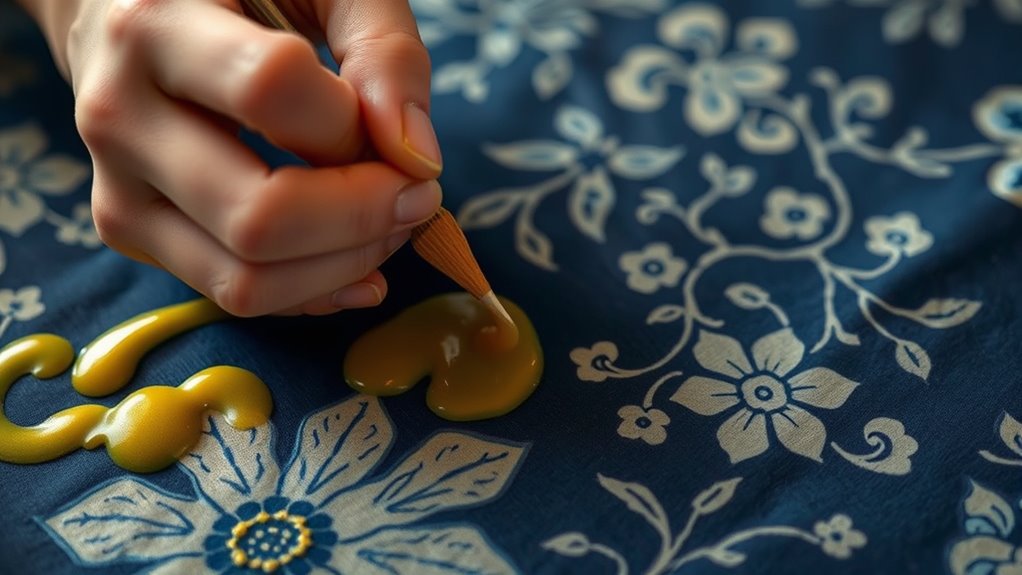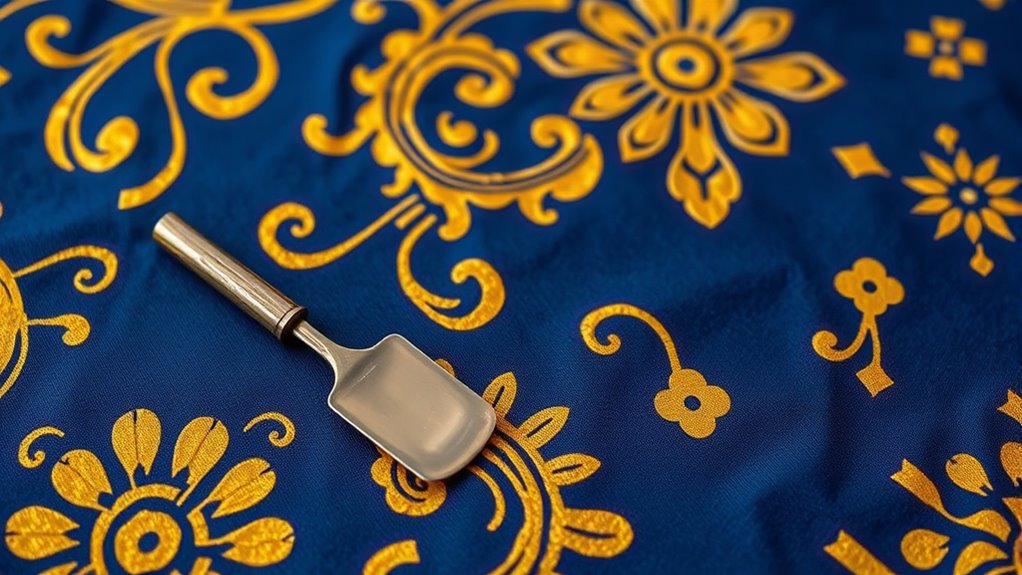Batik is a beautiful fabric art that uses a wax-resist dyeing process perfect for beginners. You start by drawing your design on fabric with hot wax using tools like a canting or tjanting. Once the wax is applied, you dip the fabric into dye, with waxed areas resisting color. Repeating this process creates layered, intricate patterns. Mastering this technique opens up a world of creative possibilities—keep exploring to learn more about creating stunning batik designs.
Key Takeaways
- The wax-resist process involves drawing designs on fabric with hot wax to create barriers against dye.
- Traditional tools like canting enable precise wax application for detailed patterns.
- Multiple dyeing layers build complex, layered designs in batik craftsmanship.
- Removing wax after dyeing reveals vibrant, intricate patterns unique to each piece.
- Beginners should start with simple designs to practice wax application and control dye diffusion.

Have you ever wondered how intricate patterns are created on fabric using a centuries-old technique? If so, you’re about to discover the fascinating world of batik, a craft rooted in traditional craftsmanship. This method involves a wax-resist process that allows you to craft detailed, vibrant designs on fabric. It’s a perfect entry point if you’re interested in textile arts, blending artistry with technical skill.
The core of batik lies in fabric dyeing, but it’s not just about coloring fabric—it’s about controlling where the dye penetrates and where it doesn’t. You start by drawing your design onto the fabric with wax, which acts as a barrier to the dye. As you apply hot wax, you’re fundamentally creating a map of resist areas, allowing the dye to seep into the uncovered parts. When you dip the fabric into dye baths, the waxed portions resist the color, leaving behind a pattern once the wax is removed. This process can be repeated multiple times with different colors to build up complex, layered designs.
Traditional craftsmanship shines through in every step of batik making. The wax application, often done with tools like canting (a small tool with a spout) or tjanting, requires a steady hand and patience. It’s a skill that’s been passed down through generations, with artisans developing their own techniques for creating fine lines and detailed motifs. The craftsmanship isn’t just about the wax application—it’s also about understanding how the fabric reacts to dye and how to govern the resist process to achieve the desired effects. Additionally, the traditional tools used in batik, such as canting, enable artisans to create both delicate and bold patterns, highlighting the importance of craftsmanship in this art form.
Crafting fine lines with canting demands skill, patience, and a deep understanding of fabric dye reactions.
While modern methods have introduced stamps and brushes, many practitioners still prefer traditional tools, valuing the precision and artistry they offer. Each piece becomes a unique work of art, reflecting the artisan’s skill and cultural heritage. When dyeing, you’ll find that the fabric’s texture and weight influence how the dye settles and interacts with the waxed areas. This interplay between fabric and dye highlights the importance of understanding traditional craftsmanship to produce quality batik.
Finally, once you remove the wax—usually by boiling or ironing—the fabric reveals your design in vibrant detail. The entire process is a dance between technique and creativity, where fabric dyeing acts as the medium for storytelling and cultural expression. Whether you’re making a small piece for yourself or a larger decorative item, mastering the wax-resist technique opens a world of possibilities rooted in centuries of tradition.
Frequently Asked Questions
What Types of Fabrics Are Best for Batik?
When choosing fabrics for batik, you want ones that allow good dye absorption and withstand fabric preparation. Natural fibers like cotton, silk, and linen are ideal because they absorb dye well and hold up to wax resist techniques. Before starting, you should prepare your fabric by washing and ironing it to remove impurities and guarantee smooth application. This helps create crisp designs and vibrant colors, making your batik project successful.
How Long Does It Take to Complete a Traditional Batik Piece?
They say “patience is a virtue,” and that’s true for creating a traditional batik piece. The time investment varies depending on size and complexity, often taking days or even weeks. As you develop your skills, you’ll work more efficiently, but mastery still demands dedication. Expect to spend significant time perfecting wax application and dyeing, making your finished work a true reflection of your effort and craftsmanship.
Can Batik Be Done With Natural Dyes Only?
You can absolutely create batik using natural dyes, but keep in mind that dye stability varies. Natural dyes often require mordants to fix the color, ensuring it stays vibrant through washing and fading. While they offer beautiful, earthy tones, they may not be as colorfast as synthetic dyes. With proper technique and mordanting, natural dyes can produce stunning, lasting batik pieces, making your artwork both eco-friendly and unique.
What Are Common Mistakes to Avoid in Batik Wax Application?
You might think that mistakes in wax application don’t matter, but they do. To guarantee design precision, avoid uneven wax coverage, which causes blurry lines and uneven dyeing. Don’t reapply wax over dried areas, as it weakens the resist. Also, steer clear of thick wax layers, which crack or peel. Practice steady hand movements, and always check your work before dyeing to keep your batik crisp and beautiful.
How Do You Preserve and Care for Finished Batik Textiles?
To preserve your finished batik textiles, you should follow proper preservation techniques like storing them in a cool, dry place away from direct sunlight. Clean your batik carefully using gentle methods, such as light dusting or hand washing with mild soap, avoiding harsh chemicals. Handle your textile with clean hands to prevent oils and dirt from damaging the fabric, ensuring your beautiful artwork remains vibrant and well-maintained for years to come.
Conclusion
Now that you’ve uncovered the secrets of wax-resist batik, you’re ready to let your creativity flow like a river, shaping vibrant patterns and unique designs. Remember, practice makes perfect—each piece is a new chapter in your artistic journey. Don’t be afraid to experiment and embrace imperfections; they’re the stars that add character and charm. So, immerse yourself and let your imagination blossom, turning simple fabric into a masterpiece that tells your story.









